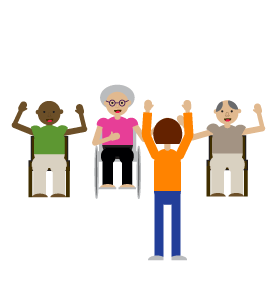- Staying well, connected to others and resilient
Dance to health Falls prevention through dance
What is the problem this innovation solves?
Dance to Health is designed to help older people who have fallen, or are at risk of falling, to improve their strength and balance.
Falls are traumatic for older people and a major challenge for the health system. They destroy confidence, increase isolation and reduce independence.
Reducing the number of falls in the UK population would help to decrease the cost to the NHS of treating patients who have had a fall, which currently stands at £2.3 billion per annum.
Solution
Dance to Health is a nationwide pioneering community dance programme for older people. It combines evidence-based falls prevention principles with the creativity, expression and energy of dance. The sessions are led by professional dance artists from leading dance companies who have been fully trained and qualified in falls prevention exercise methods.
Our classes are also designed to be enjoyable, fun experiences with other older people, which can also help to reduce isolation and loneliness.
Evidence base
Dance to Health began with a £350,000 pilot programme and the first UK older people’s dance activities survey. Findings from the pilot programme evaluation and the survey included:
- Dance to Health was attractive to older people and had waiting lists for new members
- 73% of participants completed the final two programmes
- Dance to Health can be associated with lower overall costs of managing falls.
- PSI/FaME and Otago can be ‘smuggled’ into creative, social, fun dance activity.
- 90% of older people’s dance groups are ongoing and regular and so have achieved financial sustainability
- Dance artists find the requirements of the classes artistically stimulating, not restrictive.
A £2.1 million Phase 1 expansion programme runs from April 2017 to September 2019. Phase 1 will involve over 580 participants and volunteers, and also has an associated research study. It aims to show:
- the effectiveness and cost-effectiveness of the programme
- faithful delivery of PSI/FaME and Otago principles
- a strong case for Dance to Health
Expected Impact
We hope that participants who complete the programme will have significantly increased their strength and balance enough to experience improved quality of life.
This might be to once again be able to lift a kettle to make a cup of tea, to be able to do a bike ride again, or simply be able to catch themselves when they feel like they are going to fall over.
In addition, participants may have made new friends in the group and have more social activities to take part in.
Reducing the risk of people falling and feeling socially isolated should in turn decrease the call on NHS resources.
Stage/spread (where it is/how much is there?)
Currently approximately 600 participants are taking part in one of 40 programmes we have running nationally. These located in the following six areas:
- Sandwell & West Birmingham
- Cheshire East
- Norfolk
- Oxfordshire
- Sheffield
- South Wales
What would councils/health organisations/local areas need to do or have in place to enable it to happen?
Aesop is now planning Phase 2 Roll-out. The plan is to increase participants from 600 to 3,000 participants and a randomised controlled trial with the University of Oxford Institute of Musculoskeletal Sciences. In each area we work we require partnership funding and involvement of a Health Partner – for example, CCGs and council public health and/or adult social services. We also require a suitable local Dance Partner – a dance organisation recognised by Arts Council England and expert in working with older people. In Phase 2 we will also require the support of an Community Partner organisation.
What would kill it?
In order for the programme to succeed, we have to work in collaboration with Health and Dance Partners
Where to go for more information
- Dance to Health - www.dancetohealth.org (opens new window)
- Aesop - www.ae-sop.org (opens new window)
- Contact Tim Joss, Chief Executive & Founder, Aesop – timjoss@ae-sop.org.

